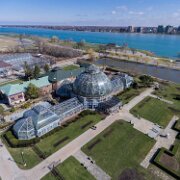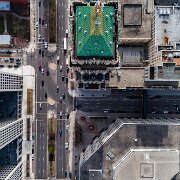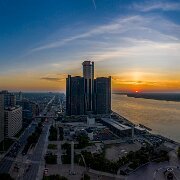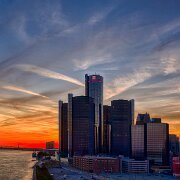
1 The Anna Scripps Whitcomb Conservatory (commonly and locally known as the Belle Isle Conservatory) is a greenhouse and a botanical garden located on Belle Isle, a 982-acre island park nestled in the Detroit River between Detroit and the Canada–United States border. The park itself consists of 13 acres of preserved land for the conservatory and its botanical garden.
Opened in 1904, the Anna Scripps Whitcomb Conservatory is the oldest continually-running conservatory in the United States.[1][2] It is named for Anna Scripps Whitcomb, who left her collection of 600 orchids to Detroit in 1955
Opened in 1904, the Anna Scripps Whitcomb Conservatory is the oldest continually-running conservatory in the United States.[1][2] It is named for Anna Scripps Whitcomb, who left her collection of 600 orchids to Detroit in 1955

3 The Fisher Building (1928) is a landmark skyscraper in the United States, located in the heart of the New Center area of Detroit, Michigan. The ornate building is designed in an Art Deco style, constructed of limestone, granite, and several types of marble. The Fisher family financed the building with proceeds from the sale of Fisher Body to General Motors. It was designed to house office and retail space.
The building, which contains the elaborate 2,089 seat Fisher Theatre, was designated a National Historic Landmark on June 29, 1989
The building, which contains the elaborate 2,089 seat Fisher Theatre, was designated a National Historic Landmark on June 29, 1989

4 The Packard Pland, Detroit Michigan
The Packard Plant, located on East Grand Boulevard in Detroit, Michigan, was once a symbol of American industrial prowess. Opened in 1903 by the Packard Motor Car Company, the factory became one of the largest and most advanced automobile manufacturing plants of its time. Designed by the architect Albert Kahn, it was a sprawling complex covering over 40 acres, consisting of multiple buildings connected by an intricate system of railways and assembly lines. The plant was at the forefront of automotive innovation, producing luxury vehicles and employing thousands of workers. Throughout the early 20th century, Packard cars were synonymous with quality and craftsmanship, catering to an elite clientele. At its peak, the Packard Plant was a hub of activity, contributing significantly to Detroit’s status as the "Motor City."
However, the decline of the Packard Motor Car Company in the mid-20th century led to the eventual abandonment of the plant. By the 1950s, competition from other automakers, changing consumer tastes, and financial mismanagement led to Packard’s demise. In 1956, the company ceased operations at the plant, and the building fell into disrepair. Despite various attempts to revitalize the site, including plans for residential and commercial development, the Packard Plant remains a striking symbol of Detroit's industrial past. The site became an iconic ruin, attracting photographers, urban explorers, and those fascinated by the history of the automobile industry.
As of March 2025, all but 2 of the buildings have been demolished
The Packard Plant, located on East Grand Boulevard in Detroit, Michigan, was once a symbol of American industrial prowess. Opened in 1903 by the Packard Motor Car Company, the factory became one of the largest and most advanced automobile manufacturing plants of its time. Designed by the architect Albert Kahn, it was a sprawling complex covering over 40 acres, consisting of multiple buildings connected by an intricate system of railways and assembly lines. The plant was at the forefront of automotive innovation, producing luxury vehicles and employing thousands of workers. Throughout the early 20th century, Packard cars were synonymous with quality and craftsmanship, catering to an elite clientele. At its peak, the Packard Plant was a hub of activity, contributing significantly to Detroit’s status as the "Motor City."
However, the decline of the Packard Motor Car Company in the mid-20th century led to the eventual abandonment of the plant. By the 1950s, competition from other automakers, changing consumer tastes, and financial mismanagement led to Packard’s demise. In 1956, the company ceased operations at the plant, and the building fell into disrepair. Despite various attempts to revitalize the site, including plans for residential and commercial development, the Packard Plant remains a striking symbol of Detroit's industrial past. The site became an iconic ruin, attracting photographers, urban explorers, and those fascinated by the history of the automobile industry.
As of March 2025, all but 2 of the buildings have been demolished

















Detroit